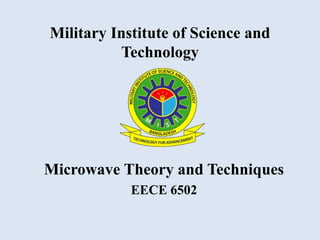
0423160001_Microwave Sensors.pptx
- 1. Military Institute of Science and Technology Microwave Theory and Techniques EECE 6502
- 2. Microwave Sensors: Advancing Technology for Enhanced Sensing and Automation Instructor: Lt. Col. Md. Aminul Islam, PhD, EME Instructor Class ‘A’ (Associate Professor) Department of EECE Military Institute of Science and Technology Presenter: H.M. Maruf Rahman Shuvo Student ID: 0423160001 Department of EECE MSc. in EECE Military Institute of Science and Technology
- 3. Overview of Microwave Sensors Microwave Sensors: A class of remote sensing devices that utilize electromagnetic waves in the microwave frequency range for various applications. How Microwave Sensors Work: Microwave Sensors work through the interaction of microwave radiation with the target or environment. A transmitter generates gigahertz frequency microwave signals and sends them out. These signals can penetrate materials like plastics, glass, and fabrics. When they encounter an object or boundary, they interact, causing reflection, refraction, diffraction, or absorption. The receiver captures the modified signals, extracting valuable information about the target's properties or environmental conditions.
- 4. Key Characteristics: • Non-Contact Sensing • All-Weather Operation • High Penetration Capability • Fast Response Time • High Accuracy and Precision Types of Microwave sensors: i. Doppler Radar Sensors ii. Continuous Wave Radar Sensors iii. Imaging Radar Sensors
- 5. Doppler Radar Sensor RCWL-9196 Principle of Operation: The Doppler radar sensor operates based on the "Doppler Effect”. When the sensor emits microwave signals towards a moving target, the frequency of the reflected waves changes based on the target's velocity. If the target is moving towards the sensor, the frequency of the reflected waves increases (higher pitch).If the target is moving away from the sensor, the frequency of the reflected waves decreases (lower pitch).By analyzing these frequency shifts, the sensor can determine the target's speed and direction of movement. Applications: • Traffic Speed Measurement • Weather Radar • Sports and Health care • Security and Surveillance • Automotive Safety
- 6. Continuous Wave Radar Sensors Principle of Operation: Continuous Wave (CW) radar sensors emit a continuous microwave signal without interruption. The sensor simultaneously transmits and receives signals, measuring the frequency difference between the transmitted and received waves. When the signal encounters a target, it reflects back to the sensor, resulting in a frequency shift known as the Doppler Effect. By analyzing this frequency shift, the CW radar can determine the target's velocity and direction of movement. AWR-1843 Applications: • Speed Measurement • Motion Detection • Level Measurement • Altimetry • FMCW Radar
- 7. Imaging Radar Sensors Principle of Operation: Imaging Radar systems use the principles of radar technology to capture and process reflected signals from objects in the radar's field of view. Unlike traditional radar that provides range and velocity information, imaging radar collects data from multiple angles to create detailed images of the target area. The radar's antenna emits electromagnetic waves, which bounce off objects and return as echoes to the sensor. By analyzing the time delay, amplitude, and phase of these echoes, the imaging radar system constructs high-resolution images. Applications: • Earth Observation • Weather Radar • Synthetic Aperture Radar • Planetary Exploration
- 8. Applications of Microwave Sensors • Motion Detection and Security Systems • Automotive Collision Avoidance Systems • Weather Forecasting and Monitoring • Industrial Level Measurement and Control • Medical Imaging Applications • Air Traffic Control and Navigation • Ground Penetrating Radar • Remote Sensing and Earth Observation • Satellite Communication • Aerospace and Defense • Traffic Speed Measurement • Short-range Wireless Communication
- 9. Advantages of Microwave Sensors: • All-weather Operation • Not-contact Sensing • High Accuracy and Precision • Wide area coverage • Immune to dust, smoke and most environmental factors Limitations of Microwave Sensors: • Vulnerable to interface • Limited resolution for some applications • Power consumption
- 10. Comparison with other sensing Technologies 1. Microwave Sensors: - All-weather operation - Longer range - Penetrate obstacles 2. Infrared Sensors: - Limited by environmental factors - Shorter range - Higher resolution for motion and temperature 3. Ultrasonic Sensors: - Non-contact - Best for indoor distance measurement
- 11. 4. LiDAR Sensors: - High-resolution imaging - Affected by fog and dust 5. Optical Sensors: - Require line-of-sight - High-resolution imaging 6. Passive Sensors: - Rely on natural radiation - Used in Earth observation and astronomy
- 12. Future Trends in Microwave Sensor Technology 1. Miniaturization and Integration 2. Enhanced Signal Processing 3. Higher Frequencies and Bandwidths 4. 5G and Beyond 5. Advanced Imaging Techniques 6. Cognitive Radar 7. Improved Energy Efficiency 8. Quantum Radar 9. Environmental Sensing 10.Space Applications
- 13. Conclusion In conclusion, the future of microwave sensors holds great promise. Advancements in miniaturization, signal processing, higher frequencies, and integration with 5G and cognitive radar will lead to more intelligent and versatile sensors. Quantum radar and improved energy efficiency will further enhance their capabilities. Microwave sensors are set to revolutionize industries, from environmental monitoring to space exploration and autonomous systems, offering transformative applications and pushing the boundaries of sensing technology.
- 15. THANK YOU